Cell Broadcast
Everything You Need To Know About the New Nationwide Warning Channel
As of February 23, 2023, customers of all Telefónica Deutschland brands and partner brands will be able to receive warning messages via Cell Broadcast on their cell phones or smartphones. In addition to the existing warning systems, warning control centers and authorities or situation centers of the federal states and municipalities can quickly and specifically warn citizens within a certain radius of impending danger in the event of an emergency.
This will be used alongside similar warning mechanisms, such as sirens or existing digital warning channels like the NINA and Katwarn warning apps. Telefónica Deutschland, like all German network operators, provides its mobile network for the transmission of warning messages. Find out more about what Cell Broadcast really is, which technical requirements are necessary to use it and how contacting the service works, on this website.
How does Cell Broadcast work?
In future, if a hazardous event occurs within a certain area, those affected will receive an alert directly via the cellular radio stations there in the form of a Cell Broadcast message. Alerts via Cell Broadcast can be received by most smartphones and cell phones. Cell Broadcast does not require the installation of a separate app. As soon as a cell- or smartphone is equipped with a SIM card and switched on, it automatically registers in the next radio cell of the mobile network to establish network reception.
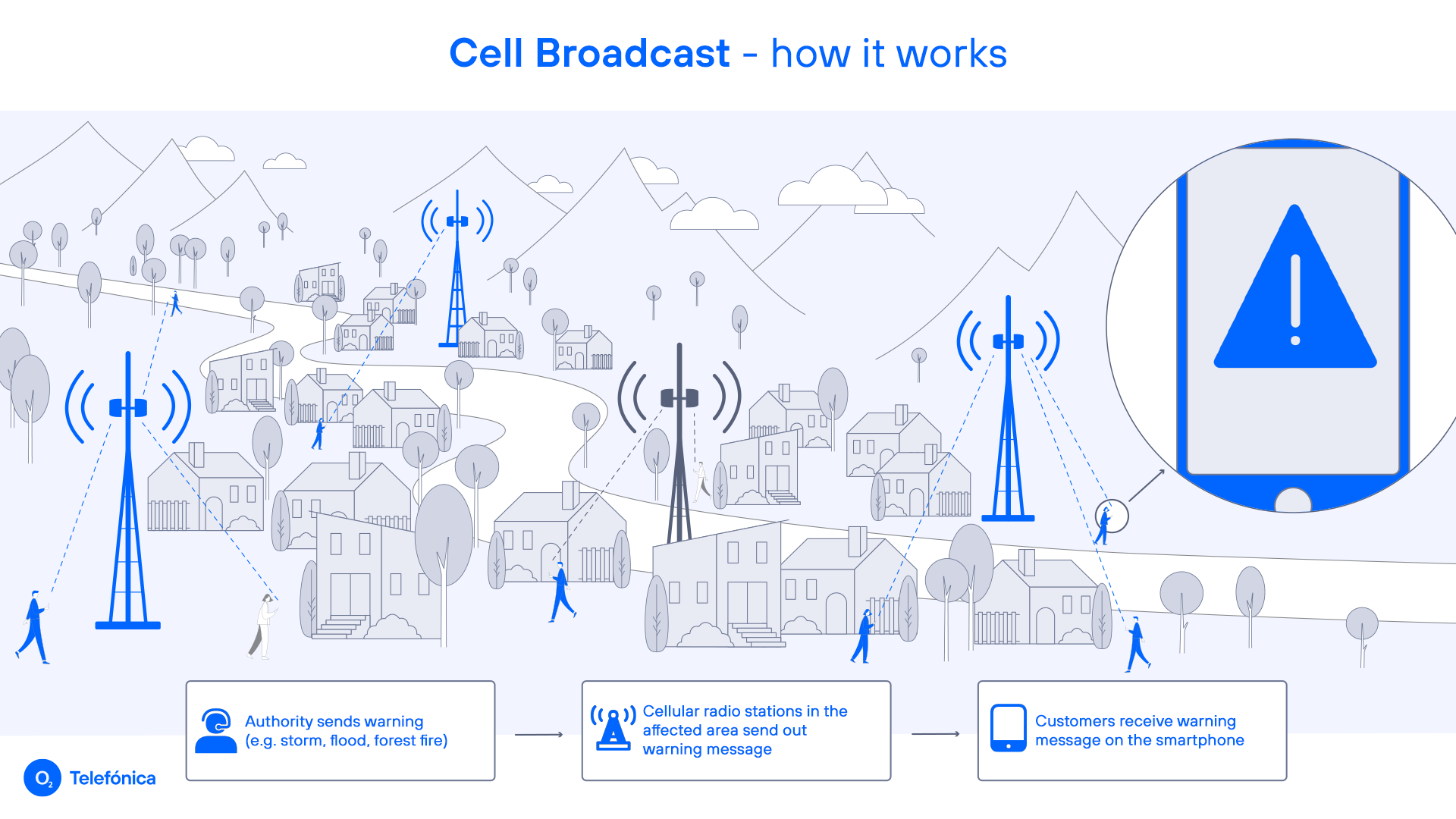
In reverse, Cell Broadcast alerts can be sent to all cell phones connected to this radio cell. This way, everyone within the area in danger, who has an appropriate setup and a “ready-to-receive mobile device” with them, simply receives the anonymous warning message, without prior checking.
The warning message shows up directly on the display and contains information about the source of danger as well as recommendations for immediate action. This message may also be accompanied by an acoustic signal, depending on the type of cell phone.
Every second counts in emergency situations – which is where another major advantage of Cell Broadcast lies: A maximum of 30 seconds elapses between the triggering of an alarm and the appearance of alerts on mobile phones in the affected area.
Important to note: The warning control centers and authorities or situation centers of the federal states and municipalities are responsible for the contents of the warning messages. The publisher of the Cell Broadcast warning is named in the message. On the nationwide warning day, the BBK is responsible for the contents of the trial warning. Telefónica Deutschland merely provides the network infrastructure and is thus the transmitter, but not the creator nor sender of the messages. If you have any further questions, please contact the BBK directly or find out more at www.warnung-der-bevoelkerung.de.
Warning day and disaster protection

Federal and state governments practice for an emergency once a year: On the so-called warning day, they check their warning systems and technical procedures in order to be able to reliably inform the population about potential dangers in case of an emergency. A mix of several warning systems is used to reach as many people as possible. In addition to radio, TV, warning apps or sirens, this now also includes Cell Broadcast.
Important to note: The warning control centers and authorities or situation centers of the federal states and municipalities are responsible for the contents of the warning messages. The publisher of the Cell Broadcast warning is named in the message. On the nationwide warning day, the BBK is responsible for the contents of the trial warning. Telefónica Deutschland merely provides the network infrastructure and is thus the transmitter, but not the creator nor sender of the messages. If you have any further questions, please contact the BBK directly or find out more at www.warnung-der-bevoelkerung.de.
In addition, as with the regular introduction of Cell Broadcast, not all users of a cell phone or smartphone will be able to receive a (test) alert via Cell Broadcast during the test phase. The reason for this is usually that older cell phone models are not able to receive Cell Broadcast warning messages.
Technical requirements and settings in the operating system

The following technical requirements must be met in order to receive alerts via Cell Broadcast:
- Your smartphone or cell phone must be turned on. You also need an activated SIM card and must be logged into the Telefónica Deutschland network.
- Your cell phone must support the reception of Cell Broadcast messages and be able to show the warning message - both via the display and, if necessary, its loudspeaker.
How to find Cell Broadcast in the cell phone settings and activate it if necessary:
As a customer of one of Telefónica Deutschland's brands or partner brands, you can check in the settings of your cell phone whether it is compatible with Cell Broadcast and everything is set up to the receival of alerts and test alerts. However, Cell Broadcast is activated in the default setting for all current mobile device models. The prerequisite is that the latest version of the operating system is installed on your end device. This is the case for iOS from version 15.6.1/16.1 onwards and Android from version 11 onwards.
Please note that we can only show examples here of how this appears on the cell phone. For other operating systems and older Android versions, the Cell Broadcast service may have to be activated by the user. In most devices, you can find the Cell Broadcast settings via the search function in the device settings. Once you have opened up the settings, simply search for "Cell Broadcast", "Warning Message" or "Emergency Notifications". Alternatively, please refer to the device-specific settings or contact the manufacturer.
Android
Path 1 - via the “Messages” app
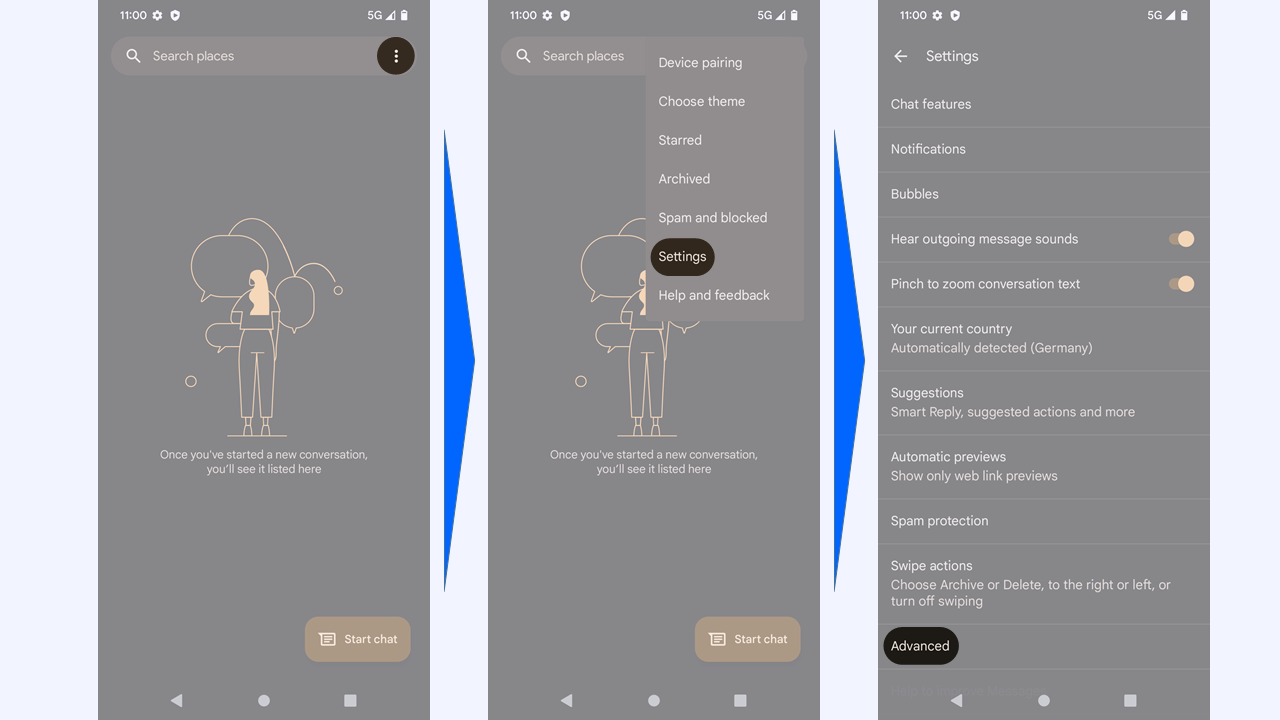
- Open the SMS messaging app.
- Go to the settings via the three dots in the upper right-hand corner.
- Click on "Advanced".
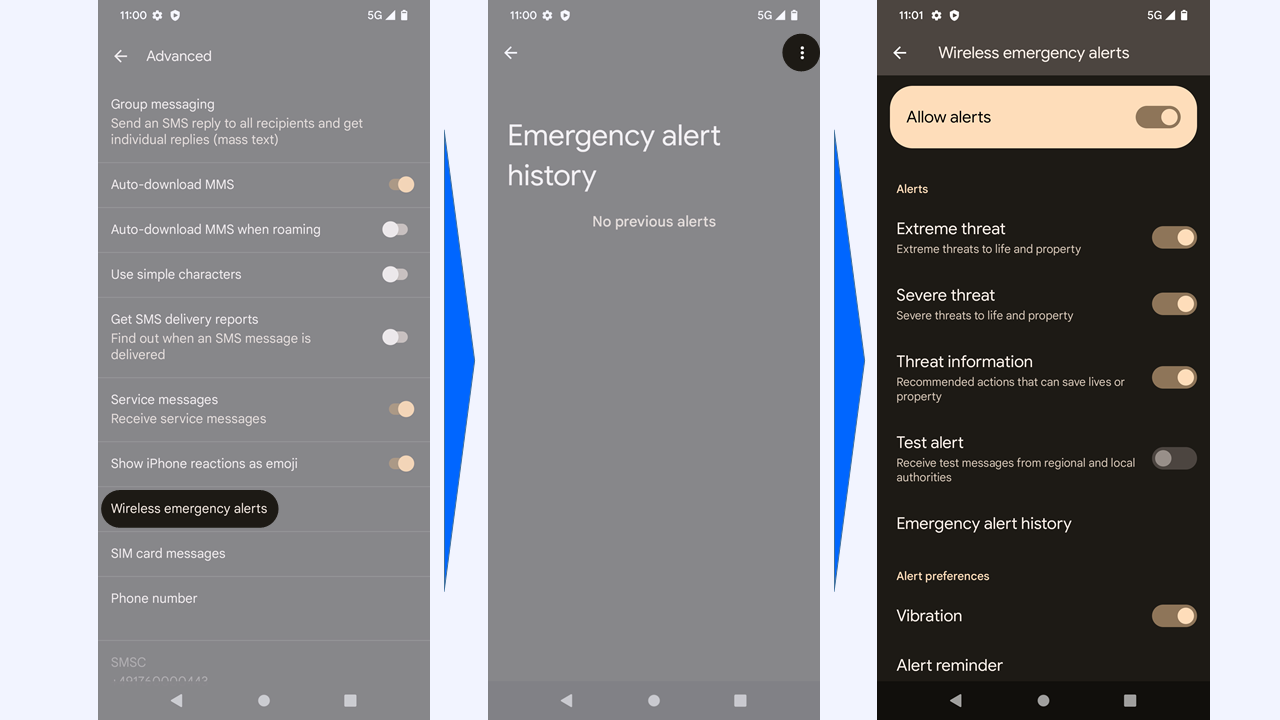
- Select "Emergency notifications for mobile devices".
- Open settings - again via the three dots in the top right-hand corner.
- Here, you can select whether you want to receive the warnings as well as test messages to your device or not.
- We recommend turning on all switches except the one for test warnings.
Path 2 - via device settings
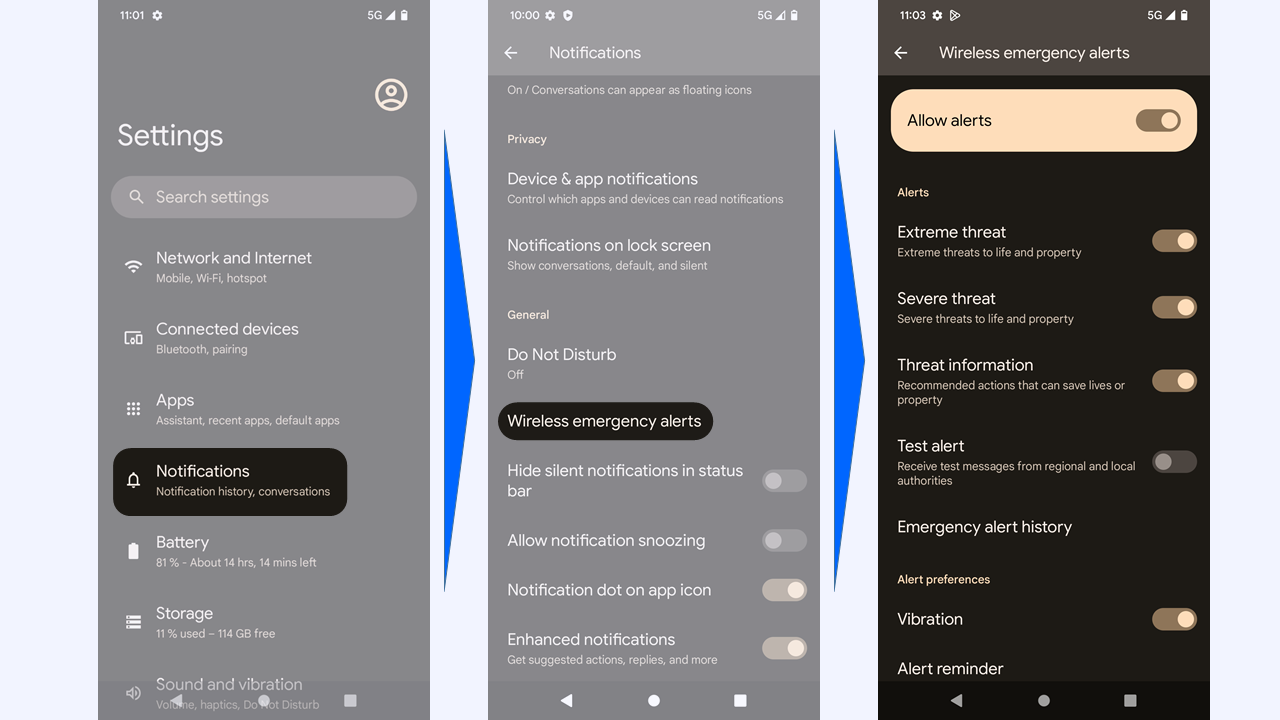
- Open the device settings.
- Click on “Notifications” in the menu.
- Select "Emergency notifications for mobile devices".
- We recommend turning on all switches except the one for test warnings.
iOS
Update iOS and Settings
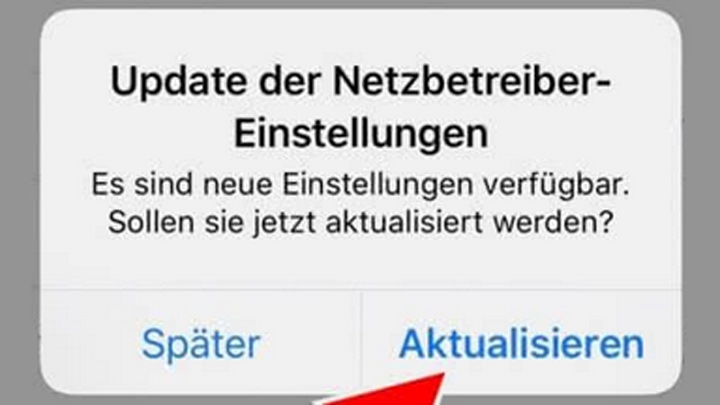
iOS 15.6.1 or higher:
- Open the device settings.
- Click on “General” and then on “Software update”.
- Accept the latest network operator settings as soon as you are notified via a pop up on the screen of your device.
- Please note that iOS 15.6. is not supported.
- Open the device settings.
- Click on “General” and then on “Software update”.
- Please note that iOS 16.0.x. is not supported.
Checking the configuration
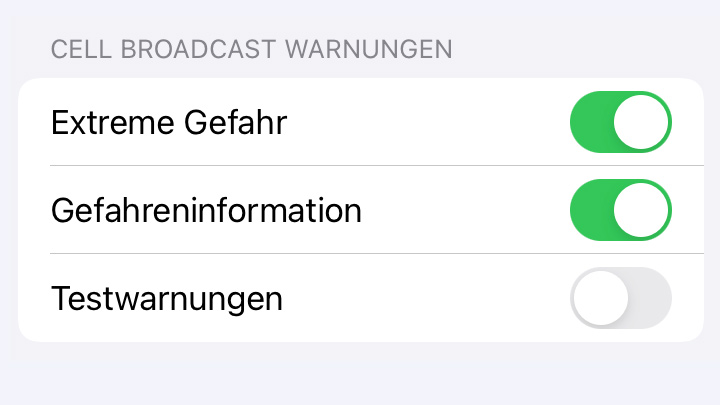
- Go to the device settings and select "Messages".
- Scroll to the bottom of the screen.
- Under “Cell Broadcast Warnings or Alerts”, you can select whether you want to receive the warnings as well as test messages to your device or not.
- These switches are turned on by default and we recommend that these are kept.
Frequently asked questions
1. How do I receive a warning message via Cell Broadcast and what does it look like?
2. Are there test and practice alerts?
3. Which devices can receive Cell Broadcast alerts?
4. Do all cell phones or smartphones within Germany always receive all warning messages?
5. Do I need to take any special setting into account on my cell phone or smartphone to receive alerts via Cell Broadcast?
6. Can I turn off Cell Broadcast alerts?
7. Is my data safe? Will my data be collected by the authorities during Cell Broadcast alerts?